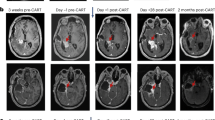Abstract
The purpose of this paper is to study prognostic factors in neuroblastoma patients treated with high-dose chemotherapy and hematopoietic stem cell transplantation. Two hundred and eighteen children over 1 year of age and treated for stage 4 neuroblastoma were enrolled in this study. The median age at diagnosis was 39 months, the sex ratio 1.5 and 84% of patients had an abdominal primary tumor. Skeletal disease was detected in 79% of cases and bone marrow involvement in 93%. N-myc oncogene amplification was present in 27% of the patients studied. The probability of event-free survival at 5 years post-diagnosis was 29% in this series. Three major favorable prognostic factors were significant and independent in the multivariate analysis: age under 2 years at diagnosis (P < 0.01), absence of bone marrow metastases at diagnosis (P < 0.04) and the high-dose conditioning regimen containing busulfan–melphalan combination (P = 0.001). The quality of response to conventional primary chemotherapy was close to significance (P = 0.053). We conclude that factors related to the patient (age) and extent of disease are predictive of outcome in patients with neuroblastoma treated with conventional chemotherapy followed by surgical excision of the primary and consolidation with high-dose chemotherapy. They should be taken into account in future prospective studies. Moreover, the type of conditioning regimen appears to be the most important prognostic factor. This should encourage new investigations into innovative drug combinations.
This is a preview of subscription content, access via your institution
Access options
Subscribe to this journal
Receive 12 print issues and online access
$259.00 per year
only $21.58 per issue
Buy this article
- Purchase on Springer Link
- Instant access to full article PDF
Prices may be subject to local taxes which are calculated during checkout
Similar content being viewed by others
Author information
Authors and Affiliations
Rights and permissions
About this article
Cite this article
Hartmann, O., Valteau-Couanet, D., Vassal, G. et al. Prognostic factors in metastatic neuroblastoma in patients over 1 year of age treated with high-dose chemotherapy and stem cell transplantation: a multivariate analysis in 218 patients treated in a single institution. Bone Marrow Transplant 23, 789–795 (1999). https://doi.org/10.1038/sj.bmt.1701737
Received:
Accepted:
Published:
Issue Date:
DOI: https://doi.org/10.1038/sj.bmt.1701737
Keywords
This article is cited by
-
Prognostic value of initial bone marrow disease detection by multiparameter flow cytometry in children with neuroblastoma
Journal of Cancer Research and Clinical Oncology (2019)
-
Validation of the mIBG skeletal SIOPEN scoring method in two independent high-risk neuroblastoma populations: the SIOPEN/HR-NBL1 and COG-A3973 trials
European Journal of Nuclear Medicine and Molecular Imaging (2018)
-
Busulfan–Melphalan followed by autologous stem cell transplantation in patients with high-risk neuroblastoma or Ewing sarcoma: an exposed–unexposed study evaluating the clinical impact of the order of drug administration
Bone Marrow Transplantation (2016)
-
Tandem high-dose chemotherapy with thiotepa and busulfan–melphalan and autologous stem cell transplantation in very high-risk neuroblastoma patients
Bone Marrow Transplantation (2016)
-
Busulfan–melphalan in high-risk neuroblastoma: the 30-year experience of a single institution
Bone Marrow Transplantation (2016)



